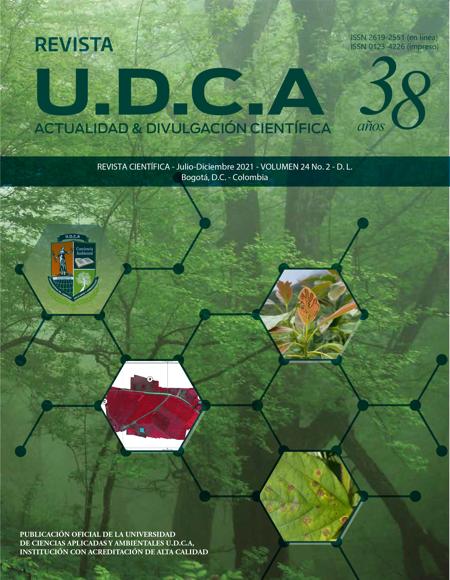Atributos afectivos y cognitivos hacia la fauna silvestre y su relación con factores sociodemográficos en población rural
Affective and cognitive attributes to wildlife and its relationship with sociodemographic factors in the rural population
Contenido principal del artículo
Resumen
Las posibles asociaciones entre factores sociodemográficos y el grado de conciencia ambiental, expresado en términos de un subconjunto de atributos afectivos y cognitivos, puede determinar la incidencia de programas de educación ambiental en zonas rurales, sobre la percepción frente a diversas problemáticas ambientales, de carácter local, así como la postura adoptada hacia la conservación de la fauna silvestre. En la zona de estudio, se observaron afectaciones al entorno, cacería ilegal, minería, deforestación, quemas y contaminación por residuos. Por lo anterior, fue importante conocer el nivel de conciencia ambiental de las personas involucradas. Además, este tipo de estudio es muy importante en el país, ya que contribuye en las investigaciones sobre el nivel de conciencia ambiental, por lo que es relevante indagar sobre este aspecto. Se tomó una muestra de 152 habitantes, pertenecientes a las 15 comunidades del área de influencia del trasvase Manso – Caldas, Colombia, a las que se les aplicaron encuestas cara a cara. Para el análisis estadístico, se recurrió a las pruebas de independencia y al análisis de correspondencias múltiples. Dentro de los atributos afectivos, se pudo identificar asociación entre la tenencia de tierra, la permanencia en la zona y el pertenecer a diferentes organizaciones de índole asociativo, con un incremento en el indicador utilizado, para evidenciar la conciencia ambiental. El estudio realizado expone el tratamiento de información empírica, que da cuenta de los avances alcanzados en programas de educación ambiental, ejecutados entre pobladores de zonas rurales, así como su relación con ciertos comportamientos proambientales.
Palabras clave:
Descargas
Datos de publicación
Perfil evaluadores/as N/D
Declaraciones de autoría
- Sociedad académica
- Universidad de Ciencias Aplicadas UDCA
- Editorial
- Universidad de Ciencias Aplicadas y Ambientales U.D.C.A
Detalles del artículo
Referencias (VER)
ÁLVAREZ, P.; VEGA, P. 2009. Actitudes ambientales y conductas sostenibles. Implicaciones para la educación ambiental. Revista de Psicodidáctica. (España). 14(2):245-260.
AZNAR, J.; GUIJARRO, F. 2012. Nuevos métodos de valoración: modelos multicriterio, 2ª Edición. Editorial Universidad Politécnica de Valencia. (España). p.33-34.
BERENGUER SANTIAGO, J.; CORRALIZA, J.A. 1998. Estructura de las actitudes ambientales: ¿orientación general o especialización actitudinal? Revista de Psicología Social (España). 13(3):399-406.
CALIXTO FLORES, R. 2012. investigación en educación ambiental. RMIE. (México). 17(55):1019-1033.
CHULIÁ RODRIGO, E. 1995. La conciencia ambiental de los españoles en los noventa. ASP Research Paper. (España). 12(a):4-5.
CRUZ, M.F.; SOTO TRONCOSO, L. 2016. Valoración actitudinal frente a temas ambientales. Revista Luna Azul. 43:448-467.
GEORGE, D.; MALLERY, P. 1999. SPSS For Windows Step-By-Step Guide: A simple guide and reference. Cuarta edición. Allyn and Bacon (Massachusetts). p.432.
GIFFORD, R.; NILSSON, A. 2014. Personal and social factors that influence pro-environmental concern and behavior: a review. Int. J. Psychol. (Canada). 49:141-157.
https://doi.org/10.1002/ijop.12034
GÓMEZ BENITO, C.; NOYA, F.J.; PANIAGUA, A. 1999. Actitudes y comportamientos hacia el medio ambiente en España. Centro de Investigaciones Sociológicas. 2(14):245-260.
GONZÁLEZ NAVARRO, M.G.; MARCHANT SAN MARTÍN, M.E.; RUÍZ RODRÍGUEZ, V.H.; NAVARRO SALDAÑA, G. 2017. Desarrollo de la dimensión afectiva de las competencias genéricas por medio del uso de la reflexión. Educación, (Costa Rica). 26(51):35-54.
https://doi.org/10.18800/educacion.201702.002
HAIR, J.; ANDERSON, R.; TATHAN, R.; BLACK, W. 1999. Análisis multivariante, 5ª edición, Ed. Prentice Hall Iberia, Madrid, (España). p.814.
HEMAYATKHAH, M.; RAHMANIAN, V.; MANSOORIAN, E. 2018. Evaluating the level of environmental behaviors among students at Jahrom University of medical sciences/ 2016-2017. J. Environ. Health Sustain. Dev. (Irán). 3(3):567-77.
HINES, J.M.; HUNGERFORD, H.R.; TOMERA, A.N. 1987. Analysis and synthesis of research on responsible environmental behavior: a meta-analysis. The Journal of Environmental Education (Estados Unidos). 8(2):1-8.
http://dx.doi.org/10.1080/00958964.1987.9943482
HOLDRIDGE, L.R. 1982. Ecología basada en zonas de vida. 1a. ed. IICA. San José, (Costa Rica). 216p.
IBÁÑEZ, M.E.; MUSITU FERRER, D.; AMADOR MUÑOZ, L.V.; MATEOS CLAROS, F.; OLMEDO RUÍZ, F.J. 2020. University as Change Manager of Attitudes towards Environment (The Importance of Environmental Education). Sustainability. (Suiza). 12(11).
https://doi.org/10.3390/su12114568
JIMÉNEZ, M.; LAFUENTE, M. 2006. La operacionalización del concepto de conciencia ambiental en las encuestas. La experiencia del Ecobarómetro andaluz. En: Castro, R. (ed.). Persona, Sociedad y Medio Ambiente. Junta de Andalucía (España). p.121-150.
LEFF, E. 2004. Racionalidad ambiental y diálogo de saberes. Polis Revista Latinoamericana. 7.
LYONS, E.; BREAKWELL, G.M. 1994. Factors predicting environmental concern and indifference in 13 to 16 years olds. Environment and behavior (Inglaterra). 2(26):223-238.
https://doi.org/10.1177/001391659402600205
MEJÍA MADERO, M.B. 2020. Relación entre conciencia ambiental y el comportamiento ecológico. Centro Sur (Perú). 4(2):74-85.
MOSTAGHNI, A.; FARASATKHAH, M.; MIZBAN, P. 2021. In the quest of a model to improve the concept of place attachment case de study: the university of art. Bagh-e nazazr. (Estados Unidos). 18(101):5-26.
http://doi.org/10.22034/bagh.2021.247858.4678
MUSITU-FERRER, D.; IBÁÑEZ, M.E.; LEÓN-MORENO, C.; CALLEJAS JERÓNIMO, J.E.; AMADOR-MUÑOZ, L.V. 2020. Fiabilidad y validez de la escala de actitudes hacia el medio ambiente natural para adolescentes (Aman-a). Revista de Humanidades (España). 39:247-270.
https://doi.org/10.5944/rdh.39.2020.25471
PASEK DE PINTO, E. 2004. Hacia una conciencia ambiental. Educere (Venezuela). 24(8):34-40.
PRADA RODRÍGUEZ, E.A. 2013. Conciencia, concientización y educación ambiental: conceptos y relaciones. Revista Temas (Colombia). 7(2013):231-244.
https://doi.org/10.15332/rt.v0i7.585
QUEZADA ORTEGA, M.J. 2007. Migración, arraigo y apropiación del espacio en la recomposición de identidades socioterritoriales. Cultura y representaciones sociales (México). 2(3):35-67.
SHEDLOVSKA, M. 2013. The conceptual model for environmental consciousness measurement. Economics & Sociology (Polonia). 6(1):78-88.
STERN, P.C. 2000. New Environmental Theories: Toward a coherent theory on environmentally significant behavior. J. Social Issues. (New York). 56(3):407-424.
https://doi.org/10.1111/0022-4537.00175
VINCES CENTENO, M.R.; MILÁN, M.R.; MUÑOZ CAMPOS, M.R. 2018. Estrategia de Educación Ambiental no Formal: contribución al cumplimiento de la Responsabilidad Socio Ambiental de la Facultad de Ciencias de la Salud, Universidad Técnica de Manabí, Ecuador. Estudios del Desarrollo Social: Cuba y América Latina. 6(3):1-14.







